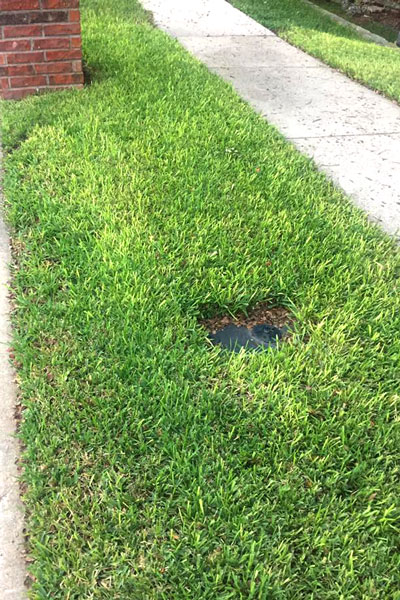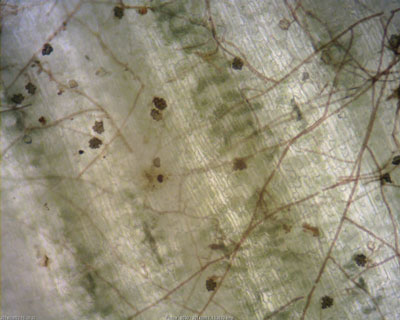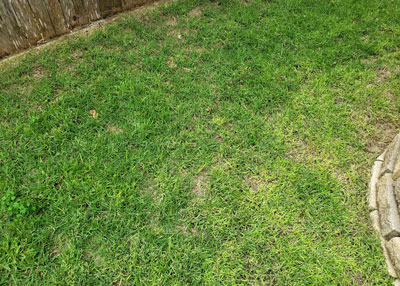Question of the Week: October 18, 2018

This image of yellowed St. Augustine was posted on my Facebook page just a few days ago. It was just one more of many.
Here’s what the reader asked…
“I’m at wit’s end on my St. Augustine. It’s still yellow, even at the end of the growing season. What’s going on?”
April and May rolled in with an onslaught of take all root rot, also known as “TARR” and “take all patch” in Texas St. Augustine.
Hot weather plowed in earlier than usual, and chinch bugs absolutely assaulted Texas lawns. Gray leaf spot soon followed and seemed to stay clear into fall. At least, that’s what I thought until the past week or so. I was still seeing the lesions on the blades, but I couldn’t figure out why it was hanging around so long after temperatures had started to drop. After all, it’s a hot-weather disease.
So I reached out to Dr. Phil Colbaugh, retired plant pathologist from the Texas Agricultural Experiment Station. Phil’s the one who’s been my mentor on many turf and ornamental diseases over the years, and I thought perhaps he could make some sense of the mess.
I sent this same photo to him and asked if he had been observing late-season yellowing like I had. Indeed he has, and he says it’s a fall infestation of TARR, not gray leaf spot at all. You could have pushed me over with a feather.
Let me step aside long enough to explain that TARR is found only in alkaline soils. You don’t see it in acidic soils east of I-45. It’s been a huge problem in DFW’s alkaline black clay soils, most especially after prolonged wet spells. I spoke in Athens two weeks ago, however, and St. Augustine there looks like it’s supposed to: lush and deep green. Acidic, sandy-clay soils, so no TARR. Heretofore it’s been only in late April and May, at least to my observations.
Back to my conversations with Phil Colbaugh…
Neil: “Have you seen TARR at anywhere near this level in the fall before?”
Phil: “No. Weather has favored the TARR outbreak, and it’s bad. About as bad as I’ve seen here in Dallas. Once the yellowing appears, the fungus has produced its toxin. Unfortunately, the yellow leaves all have the fungus toxins in them, and that’s what makes them turn yellow. They will never recover, so the spots will stay yellow. You can’t do much at this stage of infection. I am just as amazed about this issue and its severity as you are.”
Then a follow-up e-mail in which Phil added:
“This is what the TARR fungus looks like on infected leaves and stolon internodes. The black spots are hyphopodia that act like tiny suction cups that hold the fungus to the host. This confirms TARR. It is the only pathogen that has these structures. They should be visible with a hand lens or magnifying glass.”

All you need is a magnifying glass or hand lens to get your own confirmation of the presence of TARR.
Phil added this suggestion for those with infected grass:
“Spray with approved fungicide after scalping-type mowing to encourage new growth is best plan.”
Note from Neil:
4 p.m. today (Thursday) I just spoke with Phil as he got home from the Fair. After proofreading this story, he added several critical comments:
1. Do not recycle grass clippings if you have TARR active in your lawn. That spreads it all over the lawn.
2. If you have a lawn care person mowing your lawn, that person may be spreading the disease from other lawns in town.
3. There is no known resistance to TARR in different St. Augustine varieties.
4. Additional control suggestions. I am just going to copy and paste what Phil wrote after proofreading this story:
“Spray with Heritage or Clearys 3336 or at least get Bioadvanced fungus control for lawns with propiconizole.” The first two are commercial products that will probably have to be ordered from a distributor through your local retail garden center. The third is widely available through retail gardening outlets.
Phil did not suggest sphagnum peat moss be applied at this time, saying that it is a preventive treatment, not a cure. I will check back with him before spring green-up for fine-tuning of what we should do then.
Phil e-mailed me just last night to add the scientific name of this type of take all root rot. Should you want to search on university websites, it’s Gaeumanomyces graminis graminis.
Neil: “Phil, I’ve had a photo posted from San Antonio that looks like more TARR. On quick observation, would you say that TARR is a possibility on this one, too?”
Phil: “Definitely. Tell all to get a magnifying glass and examine the infection area for little black dots. These are hyphopodia that hold the fungus to the host.”

Those who have planted zoysia to get away from TARR will be disappointed to see this outbreak of the fungus in their new grass.
